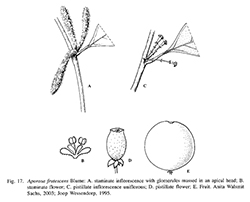e-Flora of Thailand
Volume 8 > Part 1 > Year 2005 > Page 88 > Euphorbiaceae > Aporosa
6. Aporosa frutescens Blumewfo-0000248700
Bijdr.: 514. 1825; Airy Shaw, Kew Bull. 26: 216 (excl. A. banahaensis). 1971; Whitmore, Tree Fl. Malaya 2: 59, 60. 1973; Airy Shaw, Kew Bull. Add. Ser. 4: 216. 1975. Fig. 17.
Accepted Name : This is currently accepted.
Synonyms & Citations :
Description : Shrub to tree, up to 27 m high; young branches sparsely hirsute. Stipules ovate, oblique, 5–7 by 1.5–2 mm, late caducous. Leaves: petiole terete to reniform, 4–14 mm long, lower pulvinus mainly indistinct, upper distinct; blades ovate to elliptic, 6.5–20 by 1.5–7.5 cm, length/width ratio 2.7–4.3, papery, drying greyish green to yellowish green, base cuneate to slightly attenuate, basal glands absent, margin somewhat undulate to crenulate, marginal glands small, apex acuminate to cuspidate, hirsute on midrib and nerves, very sparsely puberulous beneath, disc like glands few, along margin, venation (slightly) raised on both sides, nerves in 8–10 pairs. Inflorescences axillary. Staminate inflorescences 1–4 together, 5–22 by 2–3.5 mm, (sparsely) puberulous; peduncle 0.5–1.5 mm long; bracts triangular, 0.4–0.7 mm long; glomerules with 7–10 densely set flowers, spaced 0.5–1 mm at base, apically slightly massed in a cylindric head. Staminate flowers 0.3–0.7 mm long, sessile; sepals (3) 4, obovate, 0.2–0.4 mm long; stamens 2 (or 3), 0.3–0.6 mm long, slightly exserted; anthers 0.1–0.2 mm long; pistillode absent. Pistillate inflorescences 1–3 together, 2–7 mm long, (sparsely) puberulous; flowers single, apically at rachis; bracts triangular, 0.5–0.8 mm long. Pistillate flowers 1.5–3 mm long; pedicel 1.5–2 mm long; sepals 5 (or 6), ovate, subequal, reflexed, 1.2–1.5 mm long; ovary 3-locular, sparsely puberulous to subglabrous; stigmas sessile, 0.5–1 mm long, apically lowly lobed. Fruits juicy, globose, often with sunken stigmas, not stiped, not beaked, 9–15 by 10–15 mm, yellow to red or dark purple, drying light or brownish yellow, sparsely puberulous to glabrous, fleshy; septae and column glabrous. Seeds 8–11 by 6–9 by 3–5 mm.
Thailand : SOUTH-EASTERN: Chanthaburi (Khao Sabap); PENINSULAR: Surat Thani (Surat Thani), Krabi (Khao Pra-Bang Kram), Nakhon Si Thammarat (Yong Falls), Trang (Khao Chong), Pattani (To Mo), Narathiwat (Nikom Waeng, Su-ngai Padi).
Distribution : Burma, Malay Peninsula, Sumatra, Java (type), Borneo, the Philippines, Sulawesi, the Maluku.
Ecology : Primary, secondary, disturbed, and logged over forests; on hilltops, hillsides, hill ridges, along river banks, roads, lakes, and forests margins; in dry, swampy, or shaded areas; on a granitic or yellow-red loamy sand, red clay, blackish stony or a silty clay brown laterite soil; 0–1,500 m alt. Fruits apparently eaten by squirrels.
Vernacular : Khruen (ครืน)(Trat); mai phlong (ไม้พลอง), som mao (ส้มเม่า)(Peninsular).

